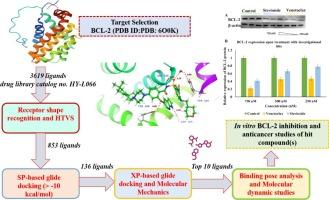采用药物再利用策略鉴定具有抗癌潜力的b细胞淋巴瘤-2 (BCL-2)抑制剂:一项基于计算机和体外的研究
IF 3
3区 医学
Q2 BIOCHEMISTRY & MOLECULAR BIOLOGY
引用次数: 0
摘要
BCL-2 (b细胞淋巴瘤-2)是许多癌症中过表达的关键蛋白。此外,它与癌细胞存活、预后和逃避细胞凋亡的能力相关,使其成为癌症化疗中重要的药物靶点。Venetoclax (ABP199)是fda批准的唯一用于治疗慢性淋巴细胞白血病(CLL)的BCL-2抑制剂。然而,与ABP199相关的BCL-2活性域突变、毒性和化学耐药进一步抑制了其未来的疗效和积极结果。考虑到这种差距和对快速药物发现的追求,我们对来自USFDA、EMA、NMPA、PMDA和药典等来源的3584种药物(hyl066,来自MedChemExpress (MCE))的数据库应用了药物再利用工具,以确定具有抑制BCL-2效力的合理线索。HTVS,随后的分子对接,使用prime MMGB-SA自由能计算的力学,以及MD模拟,使我们确定了甜菊糖苷A是BCL-2的结构先导物。甜菊糖甙通过与ASP103(羟基)、GLN99(通过氧原子)和TYR202的氢键,在受体催化位点表现出深刻而强大的相互作用和结合姿态。TYR202还与甜菊糖苷的芳香环发生π-π堆积,进一步稳定了其取向和对受体的亲和力。此外,在western blotting研究中,在750 nM浓度下观察到甜菊糖甙的最大影响,与未处理的对照相比,它使BCL-2表达减半。这种反应与venetoclax相当。因此,该结果为探索甜菊糖苷a和其他生物领域的热门药物并确定其作为BCL-2拮抗剂的影响提供了一个范围。本文章由计算机程序翻译,如有差异,请以英文原文为准。

Employing a drug repurposing strategy to identify B-cell lymphoma-2 (BCL-2) inhibitors with anticancer potential: An in silico and in vitro based study
BCL-2 (B-cell lymphoma-2) is a key protein overexpressed in numerous cancers. Further, its association with cancer cell survival, prognosis, and ability to evade apoptosis makes it an important drug target in cancer chemotherapy. Venetoclax (ABP199) is the only FDA-approved BCL-2 inhibitor for chronic lymphocytic leukemia (CLL). Nevertheless, the BCL-2 active domain mutations, toxicity, and chemoresistance associated with ABP199 further dampen its future efficacy and positive outcome. Considering the gap and quest for rapid drug discovery, we applied the drug repurposing utility on the database of 3584 drugs (HY-L066, from MedChemExpress (MCE)) from sources like USFDA, EMA, NMPA, PMDA, and Pharmacopeia to identify a plausible lead with the potency to inhibit BCL-2. The HTVS, followed by molecular docking, mechanics using prime MMGB-SA free energy calculations, and MD simulation, led us to identify Stevioside A as a structural lead for the BCL-2. Stevioside displayed a profound and robust interaction and the binding pose within the receptor catalytic site via hydrogen bonding with the ASP103 (hydroxyl group), GLN99 (via the oxygen atoms), and TYR202. TYR202 was also associated with the π-π stacking with the aromatic ring of stevioside, further stabilizing its orientation and affinity towards the receptor. Furthermore, in western blotting studies, the maximal impact of Stevioside was observed at 750 nM concentration, whereby it halved the BCL-2 expression in comparison to the untreated control. This response was comparable to the venetoclax. The outcome hence presents a scope to explore Stevioside A and other top hits in the biological arena and establish their impact as BCL-2 antagonists.
求助全文
通过发布文献求助,成功后即可免费获取论文全文。
去求助
来源期刊

Bioorganic & Medicinal Chemistry
医学-生化与分子生物学
CiteScore
6.80
自引率
2.90%
发文量
413
审稿时长
17 days
期刊介绍:
Bioorganic & Medicinal Chemistry provides an international forum for the publication of full original research papers and critical reviews on molecular interactions in key biological targets such as receptors, channels, enzymes, nucleotides, lipids and saccharides.
The aim of the journal is to promote a better understanding at the molecular level of life processes, and living organisms, as well as the interaction of these with chemical agents. A special feature will be that colour illustrations will be reproduced at no charge to the author, provided that the Editor agrees that colour is essential to the information content of the illustration in question.
 求助内容:
求助内容: 应助结果提醒方式:
应助结果提醒方式:


